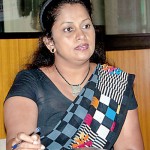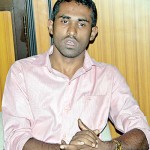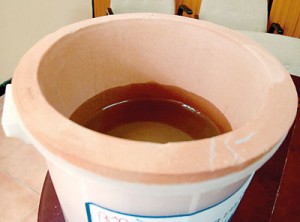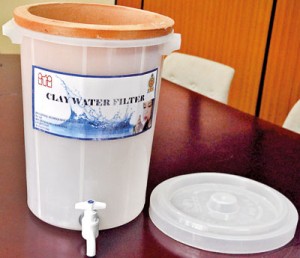News
A simple filter to strain out kidney disease ‘culprits’
It is a humble red-clay filter compared to the new-fangled and more sophisticated ones available in the market, but it may very well turn out to

Senior Deputy Director Manori Wijemanne
be a boon to the beleaguered people of the North Central Province (NCP) who are being felled by a mysterious kidney disease.
To be launched early next month during ‘Science Week’, this home-grown red-clay filter not only removes bacterial contamination from the water it purifies but more importantly some of the ‘culprits’ believed to be causing chronic kidney disease of unknown aetiology (CKDu) among NCP farmers.
While others are researching and debating the causes of CKDu and the latest thinking being that it is multi-factorial, a dedicated team at the Industrial Technology Institute (ITI) has come up with a different solution to the problem.

Technical Assistant Ruwan Arachchi
The solution is to provide precious, clean drinking water sans not only fluoride but also heavy metals such as arsenic and cadmium, to the men, women and children in areas affected by CKDu which now seems to be spreading its tentacles to Badulla and Kurunegala.
“We set about the task of producing a simple filter which could give water free of arsenic and cadmium as well as fluoride and bacteria while also being eco-friendly,” explained the project’s Principal Investigator Dr. Iresha Kottegoda, pointing out that the red-clay filter does not give out any toxic waste.
The team involved in this project, all from ITI’s Material Technology Section includes Research Scientists Dr. Lakmal Jayaratne and Charanee Dharmasiri; Research Engineers Sanjeewani Jayawardana and Asanka Premathilake; and Technical Assistants Ruwan Arachchi, Isuru Hettiarachchi and Buddhika Hettiarachchi.
Seeing and hearing the pathetic stories of those with CKDu, it was Dr. Kottegoda who came up with the concept for this ground-breaking filter in 2009, after a thorough literature search.

Principal Investigator Dr. Iresha Kottegoda
There is a five-year scientific plan for the country and ITI follows the same modalities with the criteria being that research should have an economic impact, contribute to human welfare and benefit low-income communities, says Dr. Kottegoda. The concept was to provide “pirisindu wathura tikak” to those assailed by CKDu.
Filtering of water can even be done with advanced nano-technology but that is very expensive. It had to be something which was affordable to the common man in Sri Lanka, she felt and decided on the ‘absorption technique’ after considering its cost-effectiveness.
“Many countries use charcoal, clay and alumina to remove pollutants through the absorption technique and we picked on clay which is suitable for Sri Lanka. In ancient times pieces of brick have been put into buckets having water and kept overnight before the water is drunk. There was an indigenous knowledge that such water prevented the yellowing of teeth of those who drank it,” says Dr. Kottegoda.
The team found that clay filters are being used in Cambodia and Nicaragua to tackle bacterial contamination, while in Sri Lanka too a few were being used for the same purpose.

Research Scientist Dr. Lakmal Jayaratne
Preliminary investigations followed in 2010 and when they confirmed that the project was feasible, a proposal was submitted for a grant from the Treasury in 2011.
So how did the team make use of this knowledge and also their scientific background?
The search began for “honda meti” (good clay) which would address not only the filtering of fluoride and bacterial contaminants but also arsenic and cadmium.

The red-clay filter with the filtering-through-absorption process underway indicated by the wetness on the vessel
Taking samples from different provinces of the country, they conducted chemical and physical analyses and found that the clay that fitted the bill for the best absorption was in the Western Province.
Coming up with a laboratory-scale red-clay filter at the end of 2011, the pilot trials were conducted by the end of 2012, with the ITI applying in 2012, for a local patent which is still awaited.
“The eight-litre red-clay filter will clean 24 litres of water per 24 hours. The cost would be less than Rs. 1,000 for the filter alone and less than Rs. 2,500 if it comes fitted to a food-grade plastic bucket with a tap for easy use,” says Research Scientist Dr. Jayaratne.
He adds that the life-span of the filter is two years for the removal of heavy metals and for fluoride about three months. The advantage, however, is that regeneration of the filter for

The red-clay filter with the plastic container and tap for easy use
further fluoride removal is simple and the technique can be handled by the home-user itself or by village-level organisations such as women’s groups.
Technical Assistant Arachchi, meanwhile, points out that there will be no release of the absorbed heavy metals into the environment as it is insoluble. After two years, the filter can be used as a flower pot or discarded in a landfill.
Having completed their work, the team has also verified and tallied their findings with the accredited testing service of the Sri Lanka Standards Institution and also the National Water Supply and Drainage Board, it is learnt.
The next step would be a commercial release after its launch next month.
Although the team, in all humility, believes that the red-clay filter is “a small answer” at the domestic level to the ills faced by people in CKDu-stricken areas, it seems like a big respite to a national problem.
Pix by Ranjith Perera

